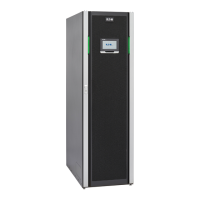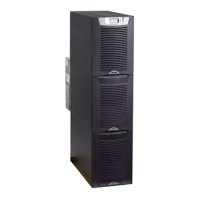37 Eaton® 9390 (100–160 kVA) UPS Installation and Operation Manual 164201604—Rev F
The emergency bypass consists of a continuous-duty static switch and backfeed protection contactor K5. The
backfeed protection contactor is located in series with the static switch. For manual transfers to bypass, the
static switch is also used. The static switch is armed and ready during both types of transfers.
The UPS module may be configured for standalone, single module, Reverse transfer (RT) operation or multiple
module, parallel redundant and/or parallel capacity operation (see 7.1 Single Module Reverse Transfer (RT) and
7.2 Multiple Module UPS Distributed Bypass System).
77..11 SSiinnggllee MMoodduullee RReevveerrssee TTrraannssffeerr ((RRTT))
A single module operates independently to support an applied load from the inverter, providing conditioned and
uninterruptible AC power to the critical load from the output of the module. During an outage, the inverter
continues to operate, supporting power to the load from the battery supply. If the unit requires service, applied
loads are transferred to the internal bypass, continuous-duty static switch either automatically or manually.
With the exception of a battery cabinet, no other cabinets or equipment are required for the single module to
successfully support its applied loads.
77..11..11 SSiinnggllee MMoodduullee RRTT MMooddeess
The Eaton 9390 UPS supports a critical load in four different modes of operation. The UPS can automatically
use all four modes, as required. The standard operation modes are:
• NNoorrmmaall mmooddee – The critical load is supplied by the inverter, which derives its power from rectified utility
AC power. In this mode, the battery charger also provides charging current for the battery, if needed.
• EEnneerrggyy SSaavveerr mmooddee – Commercial AC power is supplied directly to the critical load through the
continuous static switch and transfers automatically to Online mode if an abnormal condition is detected.
The Energy Saver mode requires a UPS with a continuous static switch.
• BBaatttteerryy mmooddee – The battery provides DC power, which maintains inverter operation. The battery supports
the critical load.
• BByyppaassss mmooddee – The critical load is directly supported by utility power.
The UPS continually monitors itself and the incoming utility power, and automatically switches between these
modes as required, without operator intervention. The sophisticated detection and switching logic inside the
UPS ensures that operating mode changes are automatic and transparent to the critical load, while internal
monitoring systems indicate the current mode of operation. The UPS switches operating modes in response to
these system events:
• A command is an intervention that is externally initiated by an operator or by some site action. A command
causes the UPS to switch operating modes; it usually does not require any further action.
• A notice is a minor system event that may or may not require attention.
• An alarm is a system event that requires immediate operator intervention.
System events, alarm horns, and indicator lights are described in Chapter 11 Responding to System Events.
The following sections describe the differences in the UPS operating modes, using block diagrams to show the
power flow during each mode of operation.
Understanding UPS Operation

